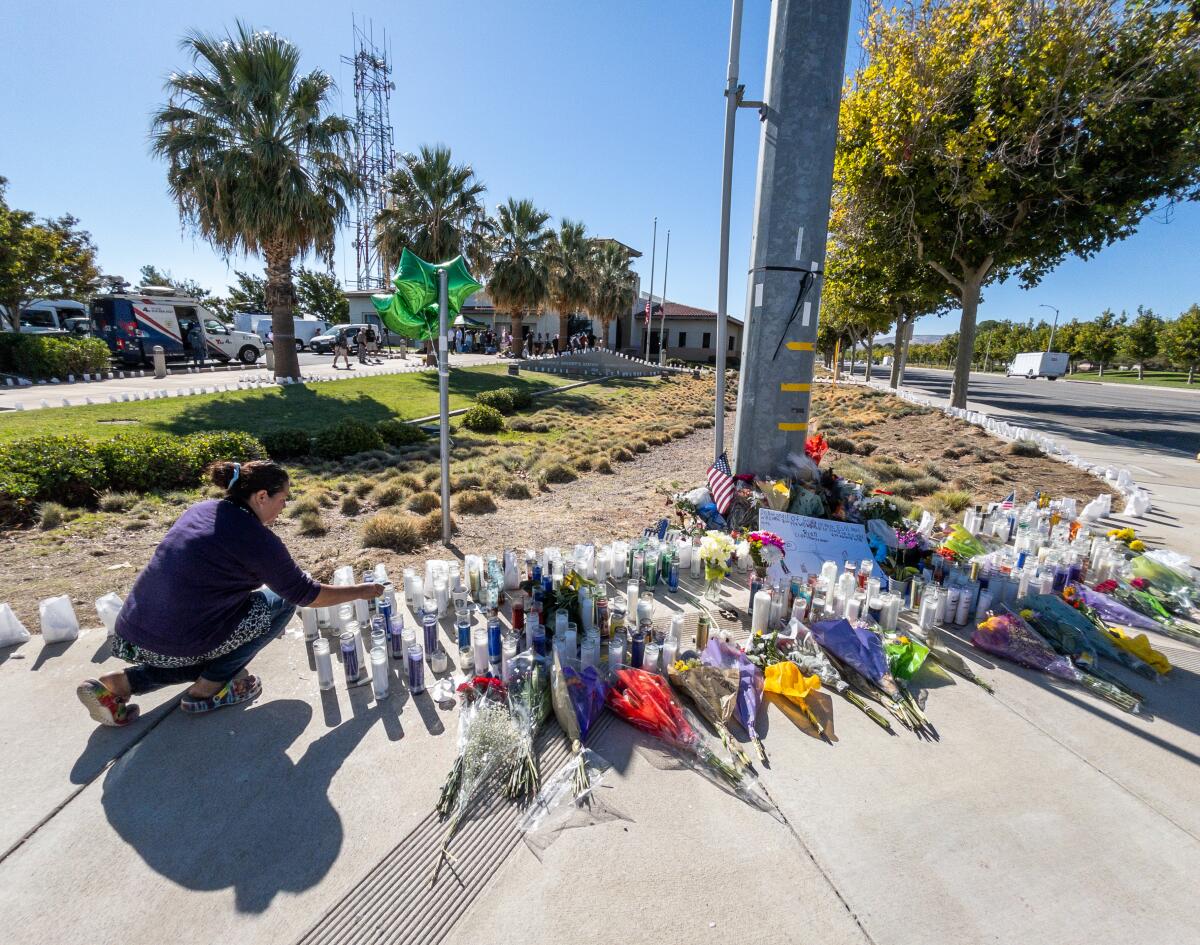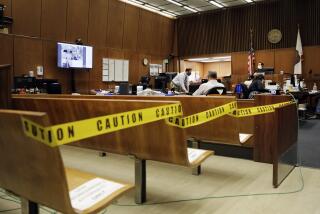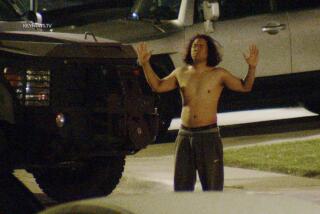He heard voices. He bought a gun. Now he’s accused of killing an L.A. deputy

- Share via
When Kevin Cataneo Salazar, 29, allegedly shot Los Angeles Sheriff’s Deputy Ryan Clinkunbroomer, he may have been using a handgun he had purchased legally despite a history of mental illness, authorities said Tuesday, raising questions about how he was able to slip through the cracks of a system designed to prevent such tragedies.
Cataneo Salazar’s mother told The Times her son had been hospitalized for mental health crises and twice attempted suicide. Experts say California laws should have prohibited him from purchasing a firearm, but the safeguard system is complicated and there are several ways he may have passed through the usual checks unnoticed.
For the record:
3:18 p.m. Sept. 20, 2023An earlier version of this article credited the California Department of Health and Children’s Services for statistics on psychiatric admissions. The data came from the California Department of Health Care Services.
Cataneo Salazar is being held at the downtown Twin Towers Correctional Facility, where he will be examined and transferred to the appropriate facilities if he needs further medical attention, officials said.
He will be charged with Clinkunbroomer’s murder, L.A. County Sheriff Robert Luna said, adding that prosecutors “will aggressively pursue this case.”
In the coming weeks, investigators will attempt to figure out how the suspect — whose mother said he heard voices in his head — was able to acquire a firearm and allegedly attack a sheriff’s deputy while he sat in his marked cruiser in front of the Palmdale sheriff’s station. Times reporters contacted law enforcement officials, mental health experts and the suspected gunman’s family to unravel the mystery.
Mental health hospitalization and admittance
Prior to his arrest on Monday, Cataneo Salazar did not have a criminal record, and he legally purchased and registered a firearm that was confiscated by law enforcement, L.A. County Dist. Atty. George Gascón said. It’s unclear if this was the same gun used in the fatal shooting of Clinkunbroomer. Investigators are said to be examining Cataneo Salazar’s mental health history and previous contacts with authorities.
In California, there are multiple avenues for people to receive mental health treatment, either through voluntary or involuntary programs. According to Marle Salazar, Cataneo Salazar’s mother, her son was diagnosed with paranoid schizophrenia about five years ago.
She called law enforcement at least twice when he became a danger to himself after not taking his medication, she said. But Cataneo Salazar had never hurt anyone, she said, and she was unaware he owned a gun.
“They’re only saying he was the one who fired the shot, but no one says he has a [mental health] record,” she said. “It wasn’t my son who did it. It’s the disease that did it.”
In a background check for a gun purchase in California, “attempting suicide is not a qualifying factor under federal or state law,” said Allison Anderman, senior counsel at Giffords Law Center, an antigun violence organization.
However, California hospitals are required to report admittance for mental health crises to the state Department of Justice, experts said, and these so-called 5150 holds trigger a five-year ban on purchasing or owning firearms.
A second 5150 hold within a year bans a person for life, according to the website of the Office of the Attorney General.
But Anderman said that spending the night in the hospital is not what the legal definition of admitted is, and “there are issues with the reporting oftentimes in mental health facilities.”
Ultimately, not all who are hospitalized for acute mental health crises are admitted. “Whether someone is admitted or not has a lot to do with whether they have beds or capacity,” not necessarily the severity of the crisis, she said.
Cracks in a system
According to his family, Cataneo Salazar was hospitalized twice due to his mental health.
He told his mother that he was hearing voices telling him to kill himself, and he devised a plan to die by jumping into an aqueduct. That resulted in an involuntary commitment in March 2019, according to his mother. The second time he was hospitalized was in September 2021, but it’s unclear if that episode resulted in a voluntary hospitalization, she said.
Around the same time, deputies with the sheriff’s department performed a welfare check at the family’s home because Cataneo Salazar was hurting himself, his mother said.
If Cataneo Salazar was in fact involuntarily committed, “he should’ve been both federally and state prohibited” from purchasing a gun, said Amy Barnhorst, associate director of the Violence Prevention Research Program at UC Davis.
An involuntary commitment generally corresponds to another type of intervention, known as a 5250 hold, which includes a court case in front of a judge or hearing officer, she said. At that hearing, the notification for federal prohibition takes place.
In addition to prohibition at the federal level, California has additional regulations prohibiting gun ownership after involuntary commitment.
Cataneo Salazar had purchased a handgun recently, according to a law enforcement source who requested anonymity because they were not authorized to discuss the ongoing investigation. Cataneo Salazar’s record indicates he was barred from purchasing a firearm in California until 2026, potentially from his involuntary hospitalization in 2021, the source said.
It is possible Cataneo Salazar lied on a form when he purchased the gun, or that he has multiple variations of his name that could have been missed in a state database, according to the source.
The California attorney general’s office did not immediately respond to requests about Cataneo Salazar’s status in the statewide database.
Red flag laws
His mother said that during a search of the family’s home following Clinkunbroomer’s shooting, authorities found three or four other firearms but that those belonged to her husband and were not accessible to her son. She said she believes only one gun belonged to her son and it was purchased within the last year.
If the family had known of Cataneo Salazar’s intent to arm himself, the state’s red flag laws could have prevented him from purchasing the weapon.
State law allows individuals — including family members — to seek a Gun Violence Restraining Order against anyone who has been deemed a threat to others or themselves. If granted, the person’s weapons can be confiscated. They will also be barred from future gun purchases.
The California Department of Justice monitors individuals who legally purchase firearms under the Armed and Prohibited Persons System, a statewide database that cross-references purchases against other records. A spokesperson for the California attorney general’s office declined to comment on whether Cataneo Salazar was flagged in the system.
The system is meant to identify people who are legally not authorized to own a firearm, including convicted felons, persons blocked under a restraining order, under the terms of their probation or flagged by a federal background check. People with “mental health triggering” events are also barred under California’s system. In 2022, the system identified 4,837 such people, according to an annual report from the California Department of Justice.
Under state law, “mentally disordered persons” can be detained up to 72 hours under 5150 holds.
If a person is being detained on an involuntary hold for 72 hours as a danger to themselves or others, the detaining facility is required to report the initiation of that hold to the California Department of Justice and “the firearms prohibition is under their purview,” said Dr. Ariel Seroussi, medical director for psychiatric emergency services at UCLA.
“A 5150 for grave disability does not, by itself, carry the same automatic reporting requirement as a 5150 for danger to self or danger to others,” Seroussi added.
Keeping a person beyond a 72-hour hold has become increasingly rare. Between 2020 and 2021, more than 120,000 adults in California were admitted to psychiatric facilities for evaluation and treatment, according to statistics compiled by the state’s Department of Health Care Services.
But of that total, 72,000 were released after 72 hours, and only 3,300 had their holds extended to 30 days.
While experts say that violent attacks by people with severe mental illness are rare, incidents such as Clinkunbroomer’s shooting have prompted calls for reform.
In 2001, when Scott Harlan Thorpe killed three people and wounded two in a Sierra Nevada town northeast of Sacramento, legislators began drafting Laura’s Law, named for one of the victims. Although Thorpe had been evaluated for a 5150 hold, he was not detained despite his family’s concerns over his deepening paranoia.
“So much of the impetus of legislation like Laura’s Law is the belief if we treat someone with serious mental illness, it will prevent these really rare events from happening,” said Joel Braslow, professor of psychiatry at Columbia University. “But it seems to me that this is not so much a crack in the mental health care system than a crack in the entire system and the availability of guns in the first place.”
More to Read
Sign up for Essential California
The most important California stories and recommendations in your inbox every morning.
You may occasionally receive promotional content from the Los Angeles Times.















